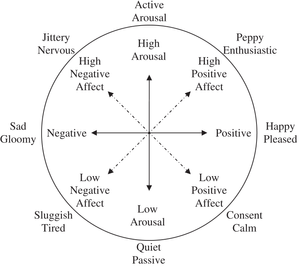The Sweetness of Discovery: Miracle Fruit Finally Understood

How often do you eat lemons whole? Would you eat them more often if they tasted like lemonade? An increasing trend in the past three years has been “flavor tripping” by means of the miracle fruit. The fruit is used mainly at parties and events specifically to eat it and taste other foods that are normally sour, sweet, and/or salty, and is not part of a normal diet.
Richardella dulfica, known as “miracle fruit” or “miracle berry,” has the power to make sour foods taste sweet and other foods transform their flavor into a candy-like saccharinity. These magical berries have long been somewhat of a culinary and scientific mystery. A team of researches from Japan and France, led by University of Tokyo’s Keiko Abe, believe that they have discovered the fruit’s sweetening secret. More
Scratching that "Cognitive Itch"
What comes to mind when you think of Friday? Friends. A night off from work. Movies. Fun. Rebecca Black? Yikes. I don’t mean to remind you of such a low point in the history of American pop-culture but there is, in fact, a small amount of useful information to be extracted from the phenomenon that is Rebecca Black. Why did her music spread like an epidemic through the minds of millions of teens and adults worldwide? This event can be loosely related to what the Germans like to call an öhrwurm.
The term öhrwurm literally translates in English to "earworm", and can be described as that inescapable occurrence of getting a song stuck in your head for an hour, a day, or even months at a time. The term is misleading in that the repetition of music does not occur in the ear but within the brain. For an experience that is so familiar to most people there is still much unknown as to how and why one contracts this stuck song syndrome. More
Behind Closed Eyes: An Ayahuasca Experience

Ayahuasca is found to produce life-changing visions but can it also produce life-changing cures?
"As I closed my eyes, images - if they can be called such - began racing at an ever-increasing speed before me. Swirls of colors, shapes, forms, textures and sounds simply overpowered me to the point where I became immobile. Like many others before me, no doubt, I became somewhat frightened. What had I let myself in for? When I opened my eyes, the phantasmagoria of forms vanished, and I saw myself in the same room with the others"
Donald M. Topping's description is very similar to the accounts many others have given. He brought up many questions on the vividness of visions produced after his very first ingestion of the hallucinogenic brew Ayahausca. What underlying brain mechanisms allow potentially healing, uplifting and fearful experiences to occur behind closed eyelids? That is what Draulio B. de Araujo and others sought out to find. More
Another Day in the Frontal Lobe: A Book Review
If you were asked to describe the consistency of the human brain, how would you describe it? Like jelly? Cottage cheese? Dr. Katrina Firlik would say tofu—the “soft variety.” In her book, Another Day in the Frontal Lobe (Random House, 2006) Dr. Firlik, a practicing neurosurgeon, offers an insider’s perspective on the world of neurosurgery and recounts the journey that got her where she is today. Through her biting wit and the compassionate nature with which she describes her many patients, Firlik paints a vivid and engaging picture of a field about which many know only a little. More
(Il)logical Lindstrom and the iPhone Infatuation

The only thing I love is my iPhone.
Ahh the Apple iPhone: sleek, sexy, and successful--monopolizing the mobile phone industry since its 2007 release. What is it about the iPhone in particular that sets it apart from its competitors, allowing it garner over 60 million followers worldwide? According to “neuromarketer” and consumer advocate Martin Lindstrom, iPhone users should not be considered addicts but rather amorous devotees who literally “love” their device. Now, I understand the dependency characteristic of an avid cell-phone user, whether Apple or otherwise. But as a neuro-nerd, I am obligated to ask: “Where’s the science behind this?” More
Esref Armağan
Most would agree that the most important of our basic senses is sight. Without it, many basic forms of communication fall apart, the vibrance of the world around us dulls, and our understanding and ability to sense the complexity of the physical world diminishes. Without the ability to see, it would logically be impossible to portray our surroundings artistically in a coherent and visually realistic manner...
...wait...what? More
Gossip Can Influence Perception
How you feel influences what you see, it is not just what you see that influences how you feel; a top down approach to understanding the visual system.
Affective Circumplex: Affect can vary in terms of valence (positive/negative) and arousal (high/low).
A great analogy for understanding how affect (the experience of an emotion) influences perception is to think of affect as a spotlight, or a source of "attention" that sheds light on the external world. This is known as a top-down process because the cortical and sub cortical levels of the brain directly influence what one externally experiences. This is opposed to a bottom-up process wherein external stimuli influences processing in the brain (an example of this process would be hearing something hit the floor behind you and immediately shifting your attention to that object). The brain uses both of these processes interchangeably, but it has only been recently that a top-down understanding of the visual system (a system that has classically been believed to be primarily regulated by external stimuli and how such stimuli influence attention) has been accepted. Many studies by Lisa Feldman Barrett and the Interdisciplinary Affective Sciences lab at Northeastern University seem to have proved strong evidence against the popular claim that the bottom-up system is the sole means by which perception can be influenced. More
What You Don't Know CAN Kill You.
Zombies are terrifying creatures. The most panic-inducing aspect of their completely factual existence among us is that they have a taste for human blood and they will do anything to get to it. Recently, the Zombie Research Society (ZRS) has been attempting to scan (with some difficulty due to the fact that zombies aren't huge fans of staying still in MRIs) and create a map of the zombie brain. A leading researcher in ZRS, Dr. Bradley Voytek, lectured about these terrors at Nerd Night SF. In his presentation he gives a medical term to describe the zombie condition: "consciousness deficit hypoactivity disorder (CDHD)- the loss of rational voluntary and conscious behavior replaced by delusional/impulsive aggression, stimulus-driven attention, and the inability to coordinate motor or linguistic behaviors." So with those messy scans and some preliminary facts we know about the living dead, researchers such as Dr. Voytek have been able to come up with multiple images of what a real zombie brain must look like. More
Neurotransmission: Now, Soon, L.A.T.E.R., or Never?
Lobsters, Axons, Telephones, and Extracellular Recordings – A look at how neuronal signals can be transmitted differently under certain pharmacological conditions.

Neuronal signals are normally transmitted from cell bodies, or somas, to terminals via extensions called axons. At these terminals, connections called synapses are made with other neurons whereby the signals are released via the aide of chemical messengers called neurotransmitters. Many still believe that axons are reliable conductors of these signals.
However, with several years’ worth of experiments, scientists have questioned the fidelity of axonal conduction. They’ve realized that axons do not work like telephones. While telephones and axons may both have buttons – at the terminals in axons – only telephones faithfully conduct signals. And only telephones ring aloud and send messages to voicemail…
In any case, neuronal signals, unlike telephone signals, can change along their paths. Moreover, the pre-synaptic neuron may communicate a different message from the one originally sent from the soma to the synapse with the post-synaptic cell. Researchers at the lab I’ve been working at this summer, the Whitney Laboratory for Marine Bioscience, have focused on the role of neuromodulation in signal transmission along axons, particularly by the well-known neurotransmitter – dopamine. More
The Hard Problem of Consciousness
You’re lying on a sandy beach on a hot sunny afternoon, enjoying a few hours of much needed laziness. As you open your eyes and confront the vastness of the ocean in front of you, light of 600nm wavelength hits your retina, kindling an impossibly long cascade of events in your brain: a molecule called retinal changes shape, neurons fire action potentials down the optic nerve, arrive at the lateral geniculate nucleus deep in the brain causing more action potentials in primary visual cortex in the back of your head, and so on ad infinitum. At some point, the mechanical wonder of 100 billion neurons working together produces something special: your experience of the color blue. What’s special is not that you can discriminate that color from others; nor that you are aware of it and paying attention to it. It is not notable that you can tell us about it, or assign a name to it. It’s that you have a subjective, qualitative experience of the color; there is something it is like to experience the color blue. Some philosophers call these experiences qualia – meaning “what kind” – but it is not important what kind of experience you are having, just that you are having one at all. Modern science hypothesizes that subjective experience is a product of the brain, but has no explanation for it. More
